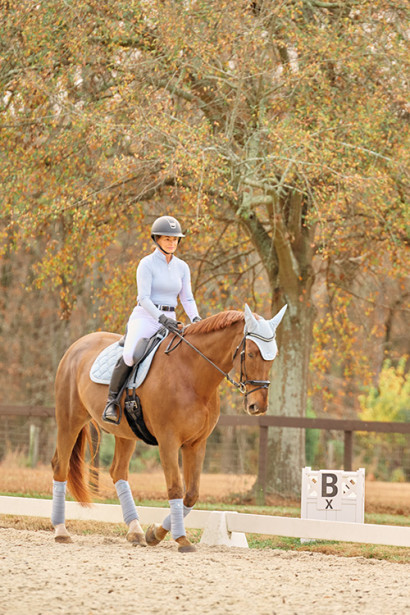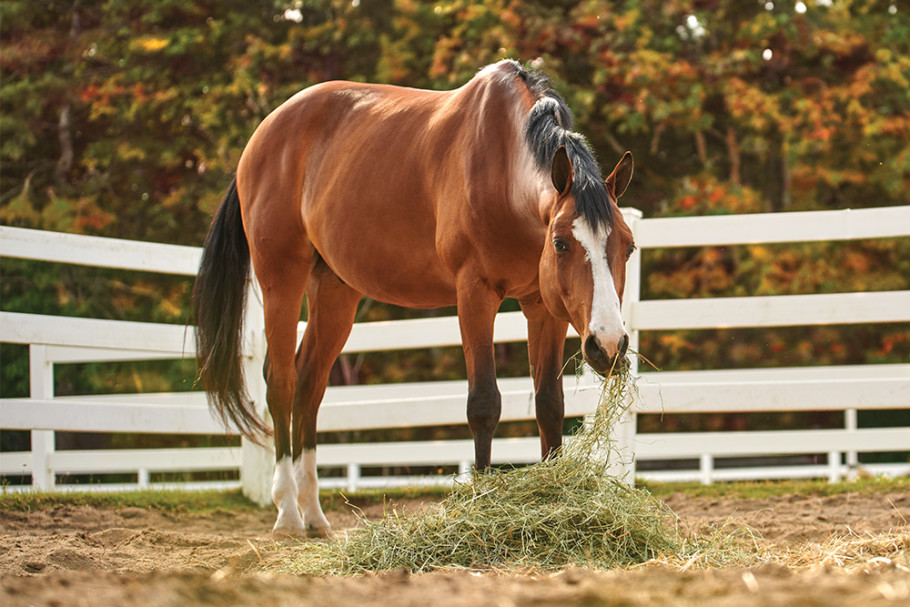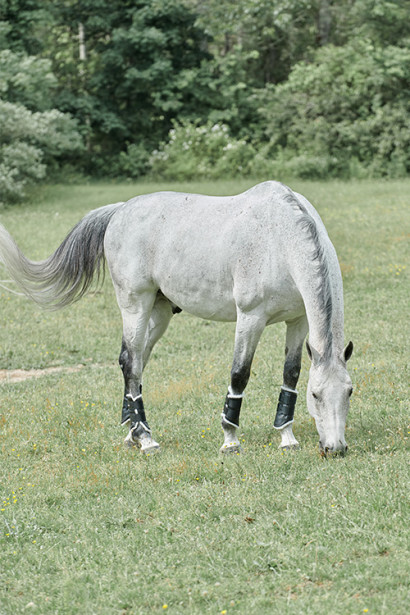What’s Stressing Your Horse?
Updated July 26, 2023
How to Reduce and Relieve Stress in Horses
In their natural state, horses tend to lead consistent, uncomplicated lives. However, even in the best barns with the most conscientious horse owner, modern horses are often subjected to unnatural stresses that can pose serious health risks, from colic to gastric ulcers and beyond.
Equine Evolution and Natural Tendencies
Horses have evolved over millions of years as nomadic prey animals who find safety in numbers, traveling as a member of a relatively consistent herd. As “trickle feeders,” horses spend most of their days grazing (10-17 hours per day!). When left to their own devices, horses spend most of their time slowly walking as they graze, only occasionally running from predators or playing.
Unnatural Stressors in Every Barn
It doesn’t matter if domestic horses live in a backyard barn or a world-class show facility; every horse is exposed to some level of unnatural stress that can put their health and well-being at risk. As much as we love our horses, it’s important to realize that domestic horse-keeping can be inherently ‘unnatural’ and stressful for them.

7 Common Practices That May Stress Your Horse
1. Large, Infrequent Meals and Limited Grazing
Because horses were designed to take in small amounts of food constantly, their stomachs always produce gastric acid to aid in digestion, whether or not there is food. Normally as horses graze, their bicarbonate-rich saliva mixes with the forage they’re consuming. This protects the sensitive stomach lining from the corrosive effects of gastric acid. The longer a horse’s stomach sits empty and unprotected between large meals, the more he is at risk for developing gastric ulcers.
The lower portion of the stomach (where gastric acid is produced) is lined with glandular mucosa. This lining is built to withstand the harsh effects of stomach acid and produces bicarbonate and mucus as an added layer of protection.
The upper portion of the stomach is lined with non-glandular mucosa. This area is less able to hold up to acid exposure and does not produce protective material like mucus and bicarb, making it much more important to feed small meals frequently or allow grazing.
2. Exercise and Training

Exercise and training, especially on an empty stomach, can significantly impact a horse’s health. Thinking about the anatomy of the equine stomach described above, if a horse is trotting and cantering on an empty stomach, all that constantly produced gastric acid can end up splashing and “sloshing” around Gastric acid could come into contact with the sensitive non-glandular mucosa and increasing the risk for gastric ulcers [1].
Additionally, exercise and training can contribute to wear and tear on joints and soft tissues [2], potentially leading to permanent, irreversible damage like arthritis. Normally, the horse’s body can repair the minimal levels of wear and tear associated with low-impact activities like walking and grazing. However, when we put a performance horse into training and exercise programs, the associated wear and tear can outpace the body’s ability to maintain and repair joint and soft tissue structures. This may result in tissue damage that can compromise soundness and performance.
3. Changing Herds
In the wild, herds are consistent, with few new adult horses joining and a steady hierarchy of dominance. This is not always the case with modern horses, who may move from barn to barn, travel for competitions, and regularly meet and interact with new horses. This can result in stress as the “pecking order” is re-established.
4. Trailering and Travel
Shipping a horse from one location to another comes with inherent stresses that can increase the risk of developing gastric ulcers [1]. Travel can also put stress on the immune system, resulting in compromised function.
5. Increased Stall Time or Stall Rest

Time spent in a stall is a fact of life for most horses, but it can have some unpleasant downsides. The stall’s confines limit movement, which can contribute to joint stiffness.
Lack of activity can also lead to reduced circulation throughout the body, which is particularly troublesome for hooves. Hoof structures are nourished by the blood circulating through the hoof, which delivers vital nutrients to help keep those structures strong and resilient. As a result, poor circulation is often a precursor to weak, cracking, and unhealthy hooves.
Most concerning of all, increased stall time is associated with an increased risk of both ulcers [1] and colic [3].
6. High-Grain Diets

Fresh pasture is a horse’s natural feed source. However, most modern barns cannot access rolling acres of green fields. As a result, many horse owners have turned to grain to add calories to their horses’ diets to help maintain weight and support energy levels.
The downside is grains are not a natural feed source for horses and are more calorie-dense than pasture. Grain also has an inverse ratio of omega 3 and 6 fatty acids. These disparities add up to high-grain diets associated with an increased risk of ulcers and colic, unhealthy weight gain, excess energy, and excitability.
7. Sudden Changes in Hay or Grain
Changing from a quarter scoop of grain to a half scoop might not seem like a big adjustment, but it can significantly impact a horse’s digestive health. Changing the type or amount of grain being fed has been linked to a 5X increase in colic risk [4]. Similarly, feeding a new cut of hay (even from the same field) or switching from grass to alfalfa has been shown to increase a horse’s colic risk up to 10 times! [4]
How to Help Your Horse with Stress
Stressed by All the Stress?
Stressors are unavoidable parts of modern horse ownership. Luckily, you can make lifestyle and management changes to provide the support your horse’s body needs to better manage stress.
Build a Smarter Diet in 5 Easy Steps
1. Focus on Forage

Considering that your horse was designed to spend over half his day roaming and grazing, it’s no surprise that the foundation of his diet should come from forage. Whether it’s fresh pasture, hay, or a combination of the two, your horse should eat 1–2% of his body weight in forage daily (for a 1,000 lb horse, that’s 10–20 lbs daily).
The best way to mimic Mother Nature would be to provide free-choice access to hay or pasture all day. However, every barn is different, and resources are limited, so work with what you’ve got and make sure you’re meeting that 1–2% requirement.
2. Consider Calorie Requirements
As forage is broken down in your horse’s hindgut, volatile fatty acids or energy is one of the by-products of the digestive process. So, if your horse is getting the recommended amount of forage, he’s also getting a major source of calories. However, some horses — “hard keepers” or those in hard work — require additional calories to maintain their ideal weight.
Since forage is your horse’s natural feed source and provides calories, adding more forage should be your first weight-gain strategy. If your horse can’t maintain his weight on forage alone, consider adding a calorie-dense feed, like grain. Since your horse was not designed to digest large amounts of non-structural carbohydrates like grains, you should aim to feed the minimum amount needed to maintain an ideal body condition score.
3. Round Out the MVPs (Minerals, Vitamins, Protein)
How you supply these nutrients depends on what else your horse is eating:
- Hay only— While your horse’s forage supplies some protein, vitamins, and minerals, it may not be enough to fulfill his daily requirements. You can do a hay analysis or forage testing to find this information. You’ll often want to provide a ration balancer to complement your horse’s forage and ensure he has the nutrients he needs.
- Hay and grain—If your horse gets a full, recommended serving of fortified grain, the protein, vitamin, and mineral needs should be met. However, as discussed above, most horses don’t need much grain. If your horse isn’t getting a full serving of grain, he also isn’t getting a full serving of vitamins or minerals. A multivitamin and mineral supplement can help bridge those gaps.
4. Add a Dash of Salt
Salt (sodium chloride) is essential to your horse’s diet. It supports healthy nerve and muscle function and encourages your horse to drink, helping to avoid dehydration. Even a horse in no work needs at least one ounce of salt daily, which increases with exercise and hot weather. Hay, pasture, and commercial feeds provide minimal salt, so top-dressing meals with salt or an electrolyte supplement can help your horse get what he needs.
5. Balance Fats
Omega-3 and omega-6 fatty acids are important to your horse’s well-being, but maintaining the correct balance is critical. Omega-6 fatty acids support pro-inflammatory reactions, and omega-3 fatty acids help anti-inflammatory responses. So, your horse should have two to four times more omega-3s than -6s.
High grain diets and lack of fresh pasture are two reasons the modern horse’s diet often has too many omega-6s and too few omega-3s, setting the horse up for a chronic state of inflammation. That’s why many equestrians look to supplement their horse’s diet with additional omega-3s.
Make Dietary Changes Slowly
As you now know, grain and hay changes can increase your horse’s colic risk 5-10 times, but it’s impossible to avoid dietary changes altogether. When you have to make changes in type or amount, make them as gradually as possible, ideally over 10 to 14 days.
Reduce Stall Time and Increase Turnout

We all have to work within the limitations of our geography and the property on which our horses live, but looking for opportunities to maximize turnout time and limit hours spent in a stall can help mirror your horse’s natural activity and environment, supporting physical and mental health and wellbeing.
Provide Supplemental Support for Areas of Unavoidable Stress
All stress cannot be avoided. However, there are ways you can make sure your horse has the support he needs to stay at the top of his game. In addition to working closely with your veterinarian, supplements are a smart way to provide daily, ongoing support.
Think about the areas in which your horse is experiencing the most stress. If he’s like many competitive eventers, his joints and digestive tract are under significant strain from exercise, training, travel, and competition. So it’s no surprise that these are among the most popular areas for many eventers to provide daily supplements for support.
To build the perfect supplement plan for your horse, visit the Supplement Wizard today for a custom recommendation to review with your veterinarian and the rest of your horse’s care team.
We Can’t Stress this Enough
If you have one takeaway from this entire article, it should be this: your horse is under chronic stress, and helping him cope with that stress is part of good horsemanship. Be mindful of the areas where his life differs from his natural state, do your best to make changes when you can, and provide support when you can’t. Your horse says thanks!
Evidence-Based References
- Videla R, Andrews FM. New perspectives in equine gastric ulcer syndrome. Vet Clin North Am Equine Pract. 2009 Aug;25(2):283-301.
- McIlwraith CW. Osteoarthritis (Degenerative Joint Disease)—An Update. Proc of the 11th International Congress of the World Equine Veterinary Association. 2009.
- Cohen ND. Factors predisposing to colic. 8th Congress on Equine Medicine and Surgery. 2003.
- Cohen N, Gibbs P, Woods A. Dietary and other management factors associated with equine colic. Proc of the Annu Conv of the AAEP 1999 (45) 96.98.